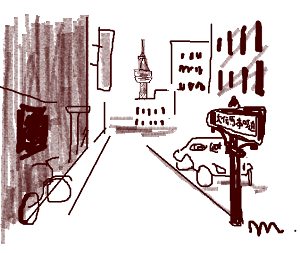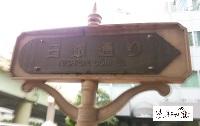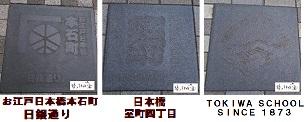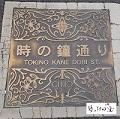Hello, this is Minato kid.
Today, I would like to walk "Odenma Honcho-dori St." from Nihonbashi Honmachi 3-chome 6 to Nihonbashi Daidenmacho 16.
♪ Otemmacho as a publishing town
In the Edo period, there was a town called "Toyu-cho". It's the 13th area of Odenmacho today. In this area, there were many Shoshi because the play town was close.
In the Genroku era (1688-1704), the scale shop dealing with joruri books, and in the Tenmei era (1781-89), it was a town famous for red-e (a type of ukiyo-e).
In such a town, there was a Shoshido by Juzaburo Tsutaya (1750-1797), a popular publisher in the middle of the Edo period.
Koshodo opened a store in this area in 1783 (1783), and published yellow covers, stylish books (Sharebon), Kyoka books, Nishiki-e, etc. Among them, many leading writers such as Ota Nanbo) and Kyoden Santo (Santo Kyoden), many of the leading players such as Katsushika Hokusai Kitagawa, and many Torakutama.
"Higamoto Toyu" Katsushika Hokusai painting
The information board of Koshodo is located along the Odenma Honcho-dori St., in the 13th area of Odenmacho.
In addition, one of the publishers who published "Tokaidochu Hizakurige" of Jukkasha 1765-1831, which has a grave in Chuo-ku, is the same Toyu-cho, You can give Jirobei Murataya.
In addition, print shops such as Senzurudo Tsuruya Kiemon, who sold the Edo calendar and Chiyo paintings, and Gun Gyokudo Matsumoto Zenbei, and Matsumodohama Matsuya Kosuke were also famous. Japanese paper is light and durable and not bulky, so these prints were perfect for Edo souvenirs.
 ♪ Otemmacho as a cotton wholesaler district
♪ Otemmacho as a cotton wholesaler district
Another characteristic of Otemmacho is the cotton wholesaler district of the former 1.2-chome.
On the north side of the former Odenmacho 2-chome, there is a mansion from Mikawa country (now eastern Aichi prefecture) and a village headman in Otemmacho. Was. It is said that the townspeople under the control opened a Mikawa cotton wholesaler in the town.
In addition, the Hamacho River, which was once excavated on the east side of Otemmacho, laid the foundation for this town to prosper as a wholesale district. In the late Edo period, "Edo Shopping Sogo Guide" states that there are 22 cotton wholesalers alone.
On the south side of Daidenma Honcho-dori St., there was a street called Daimaru Shindo (Daimaru Jinmichi) in the former Totagocho. As the name implies, in 1743 (1743), a kimono store run by Shoemon Shimomura, Daimaruya opened here.
Since then, Otemmacho has formed a cotton wholesaler area called "Momendana" and boasts its prosperity to this day.
From the Daidenma Honcho-dori St. I walked this time, I could see the Sky Tree straight ahead. Looking back, the other side of the street is the liveliness of Bettara City. Even in the old days of the Edo period, the large store in Otemmacho performed the Ebisu-ko on New Year's Day 20 and October 20.
Correspondent Minato kid, Chuo-ku Tourism Association

No. 25 October 22, 2018
 Hello, this is Minato kid.
Hello, this is Minato kid. In accordance with the Bank of Japan Ordinance promulgated in 1882 (1882), the main building of the Bank of Japan began operations as a central bank in Japan.
In accordance with the Bank of Japan Ordinance promulgated in 1882 (1882), the main building of the Bank of Japan began operations as a central bank in Japan.

 Hello, this is Minato kid. Today, we will walk "Tokikan-dori" from 4-5 Nihonbashi Muromachi to 3 Nihonbashi Kodenmacho.
Hello, this is Minato kid. Today, we will walk "Tokikan-dori" from 4-5 Nihonbashi Muromachi to 3 Nihonbashi Kodenmacho. I'm gonna
I'm gonna "The bell of Kokumachi is heard to the Netherlands."
"The bell of Kokumachi is heard to the Netherlands." On the banks of the bell at the time, in 1737 (1737), the haiku master Hayakawa Hayakawa joined an hermitage called "Yahantei". As an inner apprentice, young Buson Yosa lived here and tried to train haikai. The name of "Night Hantei" is named after the Tang poem "Night Hanno Bell Voice Passenger Ship Nishiru".
On the banks of the bell at the time, in 1737 (1737), the haiku master Hayakawa Hayakawa joined an hermitage called "Yahantei". As an inner apprentice, young Buson Yosa lived here and tried to train haikai. The name of "Night Hantei" is named after the Tang poem "Night Hanno Bell Voice Passenger Ship Nishiru".

